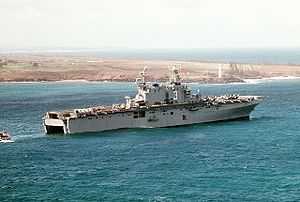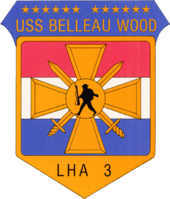USS Belleau Wood (LHA-3)
 USS Belleau Wood prepares to receive a Navy landing craft | |
| Career (United States of America) | |
|---|---|
| Namesake: | Battle of Belleau Wood |
| Ordered: | 15 November 1969 |
| Builder: | Ingalls Shipbuilding |
| Laid down: | 5 March 1973 |
| Launched: | 11 April 1977 |
| Commissioned: | 23 September 1978 |
| Decommissioned: | 28 October 2005 |
| Struck: | 28 October 2005 |
| Homeport: | San Diego, California |
| Fate: | Expended as a target, 13 July 2006 |
| Badge: |
 |
| General characteristics | |
| Class and type: | Tarawa-class amphibious assault ship |
| Displacement: | 40,000 tons |
| Length: | 820 ft (250 m) |
| Beam: | 106 ft (32 m) |
| Draft: | 26 ft (7.9 m) |
| Propulsion: | Steam Turbine |
| Speed: | 24 knots (44 km/h; 28 mph) |
| Troops: | 2,000 Marines plus equipment |
| Complement: | 930 officers and sailors |
| Armament: | 2 × 21 cell RAM launchers 2 × 20 mm Phalanx CIWS 4 × 25 mm Mk 38 Bushmaster gun mounts 5 × .50 cal mounts |
| Aircraft carried: | 30 helicopters and Harriers |
USS Belleau Wood (LHA-3), nicknamed "Devil Dog", was the second ship named after the battle of Belleau Wood in World War I. Her keel was laid down on 5 March 1973 at Pascagoula, Mississippi, by Ingalls Shipbuilding. She was launched on 11 April 1977, and commissioned on 23 September 1978, with Captain T.C. Steele in command.
Belleau Wood was the third of five ships in a new class (Tarawa-class) of general-purpose amphibious assault ships and combined into one ship type the functions previously performed by four different types: the amphibious assault ship (LPH/Landing Platform Helicopter), the amphibious transport dock (LPD), the amphibious cargo ship (LKA), and the dock landing ship (LSD). She was capable of landing elements of a United States Marine Corps battalion landing team and their supporting equipment by landing craft, helicopters, or a combination of both.
Operational history
Homeported in NS San Diego, California in October 1978, Belleau Wood participated in her first full-scale operation in 1979 off the coast of Hawaii. In early 1979, she reported to Long Beach Naval Shipyard in Long Beach, California for a one-year engine overhaul.
Belleau Wood began her first major deployment in January 1981. The ship rescued 150 Vietnamese refugees, earning the crew the Humanitarian Service Medal. The deployment included three major exercises and eight port visits. Belleau Wood returned to San Diego in August 1981.
August 1982 marks the ship's second deployment where she participated in four major amphibious exercises in the Philippines, Thailand, Somalia, and Australia - including Valiant Usher; Team Spirit and Jade Tiger 83 and eleven port visits. Port visited were Honolulu, Hawaii (2 times); Hong Kong; Subic Bay, Philippines (2 times); Singapore (2 Times); Phuket Thailand; Diego Garcia; Barbara Somalia; and Perth, Australia. Return to San Diego in February 1983. She went to an extensive yard period in Naval Station Long Beach for almost eight month from early March to late October 1983. Her third successful deployment ran from January 1984. Joined numerous major amphibious exercises in Hawaii, Korea and the Philippines. Visited twelve ports such as Honolulu, Hawaii (2 times); Hong Kong (2 times); Subic Bay, Philippines (2 times)]; Yokosuka, Japan; Singapore; Pohang Korea; Pusan Korea and Phuket, Thailand. Returned to homeport in mid July 1984.
The ship then completed an 11-month complex overhaul at Puget Sound Naval Shipyard, Bremerton, Washington from March 1985 to February 1986. Then returning to home base Naval Station San Diego.
In 1986, scenes for 'Heartbreak Ridge' with Clint Eastwood were shot. In the movie the interior shots were USS Belleau Wood, the exterior shots were USS Tripoli.
After completing numerous exercises 1986, the ship received the Battle-E,for Battle Readiness and was ready for deployment.
In January 1987, Belleau Wood got underway for her fourth deployment. The crew participated in four major exercises, including the first winter amphibious exercises conducted off the Aleutian Islands in the Bering Sea since World War II, and introduced the ship to the AV-8B Harrier "jump jet". The ship also received the Admiral Flatley Memorial Award for Aviation Safety in 1987.
Whilst in the Bering Sea, the ship and crew battled 90-foot seas sailing through a Super Storm, where two Cyclones merged. Extensive damage caused an extended stay at Naval Shipyards, Subic Bay in the Philippines. Other Ports of call included Okinawa Japan; Pohang South Korea; Pusan South Korea; Pattaya Beach Thailand and Phuket Thailand
In May 1987, Belleau Wood rescued Korean ROK's off the coast of Cambodia under enemy fire.
After the Crossing the Line Ceremony at the Equator, Belleau Wood lost both engines and one of two generators causing her to be towed into Sydney Harbour, leaving her with the unfortunate nickname 'Driftwood'. Both the Belleau Wood and Midway Battle Groups sailed into Sydney Harbour. After which, the Battle Groups participated with the Australian Navy in exercises.
On June 23, 1987, The crew crossed Latitude 00000 and Longitude 180, the Equator at the International Date Line. Those who participated in the Ceremony became 'Golden Shellbacks.'
Returning from deployment, July 1987, Belleau Wood hosted the 'Tiger Cruise' for male family members of the crew, sailing from Honolulu HI to San Diego CA.
_and_USS_Reasoner_(FF-1063)_underway_during_RIMPAC_1990.jpeg)
Belleau Wood underwent repairs at the Long Beach Naval Ship Yards, 1987-1988.
In January 1989, Belleau Wood departed for the Western Pacific. Over the next five months, the ship participated in Exercise Team Spirit 89 in Korea and Exercise Valiant Usher in the Philippines and Korea.
On 4 October 1989, the ship hosted the Minister of Defense of the Soviet Union during his historic visit to the United States.
Belleau Wood entered her second complex overhaul at the Long Beach Naval Shipyard in 1990. Major work included an upgrade to CIWS and installation of the Rolling Airframe Missile (RAM) System.
On 31 August 1992, Belleau Wood sailed out of San Diego, bound for her new homeport in Sasebo, Japan. During this transit, the ship provided disaster relief to the people of Kauai, Hawaii after Hurricane Iniki ravaged the island. For this, the crew was awarded its second Humanitarian Service Medal. On arrival in Japan, Belleau Wood joined Amphibious Group 1 and Amphibious Squadron 11, and became the world's only forward deployed large deck amphibious ship.
On 24 November 1992, Belleau Wood became the last ship to sail out of the Philippines while conducting the final withdrawal of U.S. forces from Subic Bay Naval Base and Naval Air Station Cubi Point.
Following her move to Japan, Belleau Wood became a familiar sight at joint military exercises such as Valiant Usher in Australia, Team Spirit in Korea, Cobra Gold in Thailand, and Tandem Thrust near Guam (originally in Australia). Belleau Wood also became the first large-deck Navy ship to undergo pierside maintenance by COMLOGWESTPAC in Singapore.
From January to April 1995, Belleau Wood served as the Command Platform for Operation United Shield[1]
Belleau Wood was deployed to East Timor as part of the Australian-led INTERFET peacekeeping taskforce from 5 to 28 October 1999.[2]
_Sailors_%5Eldquo%2Cman_the_rails%5Erdquo%2C_for_the_final_time_as_they_sail_through_San_Diego_Harbor_completing_her_final_voyage_after_27_years_of_service.jpg)
In July 2000, Belleau Wood took part in the largest crew swap to date when she was relieved as forward deployed amphibious assault ship. The procedure started when USS Essex (LHD-2) arrived in Sasebo on 13 July 2000. The swap was part of a planned rotation of forward deployed naval forces in Japan, and was the third crew-swap exchange. The ships’ crews simply switched ships, minimizing the impact of moving families from homeport to homeport. Sailors in Sasebo assigned to Belleau Wood, moved on to Essex, while sailors from San Diego assigned to Essex moved aboard Belleau Wood. Belleau Wood and the San Diego-based crew then returned to San Diego in mid-August to begin overhaul and maintenance cycles.
_sinking.jpg)
During 2002, Belleau Wood was the backdrop for the making of the movie Antwone Fisher.
In November 2003, Belleau Wood was the site of another first when Brigadier General Joseph V. Medina took command of Expeditionary Strike Group Three, of which Belleau Wood was the flagship. This event marked the first time in history that a United States Marine Corps officer took command of a naval flotilla.
In July of 2004, the "Belleau Wood" lead the ARG that transported the 11th MEU to Kuwait and disembarked the Marines. After months of sailing in the Persian Gulf, the ships returned to San Diego without the Marines who later flew back to CONUS.
The ship was decommissioned on 28 October 2005. She was expended as a target and sunk off the coast of Hawaii as part of RIMPAC '06 exercises on 13 July 2006.
Significance of the name

The ship was named in memory of the World War I Battle of Belleau Wood, in which United States Marines of the Fourth Brigade, American Expeditionary Forces, defeated German forces after nearly four weeks of intense fighting. It is said that the Germans referred to them as Teufel Hunde (correctly "Teufelshunde")—Devil Dogs—and it was this moniker that became the ship's mascot, and one of the nicknames for US Marines (Devil Dog).
Coat of arms
The official seal of Belleau Wood is a blend of symbols. An image of a fighting U.S. Marine, in World War I battle dress, is at the center of the plaque. He carries a rifle with bayonet, and seems to be beckoning someone to follow him. Surrounding the figure are the gold cross, shield and swords of the Croix de guerre, the French medal awarded to the Marines who distinguished themselves at Belleau Wood. In that tradition, Marines of the Fourth Brigade are permitted to wear the French fourragère to this day.

Twelve gold battle stars in a field of blue line the top of the coat of arms. They stand for the World War II record of the first USS Belleau Wood (CVL-24). The gap between the sixth and seventh stars represents the ship's only break in her war record. On 30 October 1944, while off Leyte Gulf, Belleau Wood was struck by a kamikaze. The light aircraft carrier had to undergo repairs and an overhaul, hence the gap.
Blue and gold, prevailing hues of the coat of arms, are the traditional colors of the United States Navy. The tricolor (red over white over blue) is a reminder that the Battle of Belleau Wood occurred in France, and that Marines who gave their lives at Belleau Wood did so in the defense of another nation's freedom. The segments also bring to mind the colors of the United States.
References
- ↑ USS Belleau Wood (LHA-3)
- ↑ Stevens, David (2007). Strength Through Diversity: The combined naval role in Operation Stabilise (PDF). Working Papers 20. Canberra: Sea Power Centre - Australia. p. 14. ISBN 978-0-642-29676-4. ISSN 1834-7231. Retrieved 6 September 2010.
- Much of the information for this article came from the USS Belleau Wood Public Affairs Office.
External links
| Wikimedia Commons has media related to USS Belleau Wood (LHA-3). |
- United Shield Pictures Aboard USS Belleau Wood at greenmarines.com
- USS Belleau Wood at history.navy.mil
- USS Belleau Wood at Navsource.org
- USS Belleau Wood at Navysite.de
- USS Belleau Wood Veterans' Association homepage
- Honolulu Advertiser article about ship in mothballs
- Pictures of the sinking of USS Belleau Wood at StrategyPage.com
- USS Belleau Wood history at U.S. Carriers
| ||||||||||||||